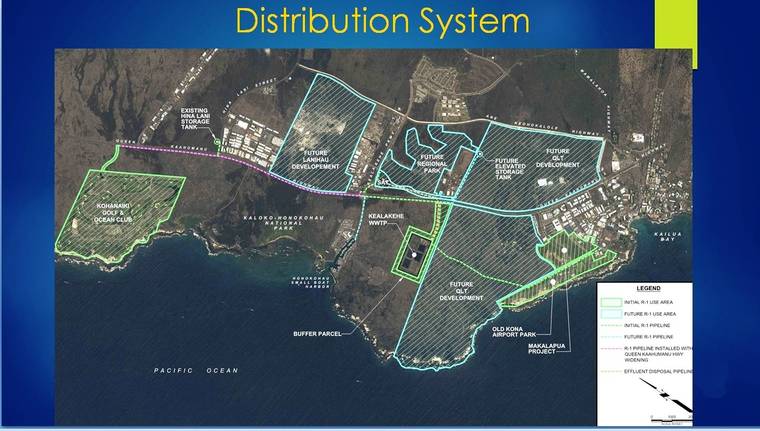A delay in design plans for the $75 million Kealakehe Wastewater Treatment Plant frustrated members of the county Environmental Management Commission, who grilled the administration Wednesday about why the county can’t simply stop illegal discharges altogether.
Environmental Management Director Bill Kucharski said design plans remain on hold while the county grapples with a U.S. Supreme Court ruling in a similar case on Maui. Other parts of the process of building a system for R-1 recycled water to be used for irrigation continue, however, such as a State Historic Preservation Division review and an environmental impact statement, which are expected to take about a year.
Kucharski said his department is working with the University of Hawaii to conduct a tracer study to see where treated wastewater from the plant is going.
“Right now we don’t know where Kealakehe discharges,” Kucharski said. “We have no way of knowing for sure.”
That didn’t satisfy some commission members and others invited to discuss the issue during a Zoom board meeting. In what became increasingly tense back-and-forths with Kucharski, they said the tests aren’t needed because a dye test was already conducted.
Besides, said Commissioner Dee Fulton, if the county designed the plant to not discharge any wastewater, a National Pollutant Discharge Elimination System permit would not be required.
“The course of DEM is to seek a permit to continue to pollute,” Fulton said. “This response to continue to go down the permit path to continue to pollute … it’s unacceptable to me personally.”
Kucharski said the Kealakehe plant discharges about 4 million gallons per day of treated wastewater, compared to cesspools on the island that he estimated made up the bulk of the 25 million gallons per day of discharge.
“There is no unequivocal data that shows our discharge is going into the water,” he said. “There is no background data and until such time as I see that, I’m not going to say that’s what we’re doing. … The study I saw was absolutely inconclusive.”
Kucharski said an NPDES permit would be required for an R-1 system “whether we discharge one drop or 3 million gallons.”
“We can try to wish away these requirements, but that’s not going to make them go away,” he said.
The Supreme Court ruled April 23 in County of Maui, Hawaii v. Hawaii Wildlife Fund that permits are required if the addition of the pollutants through groundwater is the “functional equivalent” of a direct discharge from the point source into navigable waters.
The Clean Water Act requires “point sources” of pollution to obtain permits for polluting navigable waters. Discharging without a permit can subject polluters to fines of more than $50,000 per day.
Rick Bennett, a former commissioner who is president of Applied Life Sciences LLC, participating in the meeting as an invited presenter, said it’s no mystery where the discharge is going. He said 3.6 million gallons a day move through the headwall of Honokohau Harbor and head out to the ocean.
“This has been going on for 25 years. It’s time for us to say we know enough and act in the interest of the resource,” he said.
The commission is sending letters to DEM and the County Council urging them to act as soon as possible to invite dialogue with private companies with the intent of developing a water reuse plan for the Kealakehe plant.
Commissioner Georjean Adams said “beating up on DEM” won’t solve the problem. She said the county needs to push to find someone who’s interested in using the R-1 water so it won’t be discharged.
“In the ideal, we do not want to discharge,” she said. “We have to find someone who can use it.”









